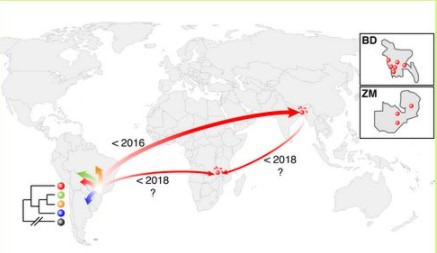Wheat blast, Magnaporthe oryzae pathotype Triticum, is a fungus with devastating implications for wheat crop. It was originally detected in Brazilian wheat fields in 1985 and quickly spread over most of the South American continent in the following years. In 2016, the first wheat blast pandemic beyond South America hit Bangladesh and affected more than 15 000 hectares of fields, causing huge losses in wheat yield. Less than two years later, Zambian farmers were also struck by a wheat blast pandemic, a first for the African continent. Until now, there has been no confirmation if all of these pandemics were caused by the same pathogen which had travelled between the continents or if they were the result of other Magnaporthe oryzae pathogen strains shifting their host species to wheat.
To answer this question, Prof. Sophien Kamoun and his team at The Sainsbury Laboratory in Norwich collaborated with Dr Batiseba Tembo (Zambia Agriculture Research Institute), Prof Tofazzal Islam (Institute of Biotechnology and Genetic Engineering in Bangladesh) and colleagues from The Graduate School of Agricultural Science in Japan, the International Maize and Wheat Improvement Center (CIMMYT) in Mexico, the Laboratory of Evolutionary Biology in Switzerland and the Department of Entomology and Plant Pathology in Tennessee (USA). Together, they analysed samples of pandemic wheat blast from the three continents.
Molecular analyses showed that precisely the same set of 84 genetic markers were present in samples from Bangladesh, Zambia and Bolivia, linking the countries through a single pandemic clone called B71. All the samples from Zambia collected from 2018 to 2020 were the same clone indicating that there was probably only one introduction. This was also the case for the Bangladeshi samples from 2016 to 2020, implying that it’s unlikely that there were further introductions after the first one in 2016. The clone match found in Bolivia was sampled in 2012 and probably originated from other South American populations. More recently, the genomes of 13 M. oryzae isolates were sequenced and by analyzing this data we could gain more insight into the potential evolution and adaptation of the B71 pandemic clone.

Dispersal of the Magnaporthe oryzae B71 clonal lineage across three continents. Colours of spheres and arrows indicate lineages of the wheat blast fungus. Arrows indicate possible routes and years of dispersal. Inserts on right side: Spheres indicate sampling locations in Bangladesh (BD) and Zambia (ZM).
Open science and international collaborations were at the core of the successful tracing and identification of wheat blast clones from all over the world. By creating the website Open Wheat Blast (go.nature.com/bkczwf), the rapid sharing of data was facilitated between researchers, which proved crucial for tracking wheat blast pathogens.
These findings rule out that the Zambian wheat blast pandemic was caused by a host jump from other African grass pathogens to wheat. The authors of the report, describing these new findings, conclude that the pathogen that caused the wheat blast pandemics in Bangladesh has spread to Zambia. There is also an indication that this same Zambian population has successfully established under rainfed conditions at different sites within the country. Knowing that this pandemic clone is genetically similar to those in South America and Bangladesh means that Zambian farmers can benefit from using similar wheat blast management strategies that have proven successful over the years.
Click here to see more...